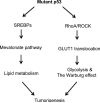Tumor suppressor p53 and its mutants in cancer metabolism
- PMID: 24374014
- PMCID: PMC4069248
- DOI: 10.1016/j.canlet.2013.12.025
Tumor suppressor p53 and its mutants in cancer metabolism
Abstract
Tumor-suppressor p53 plays a key role in tumor prevention. As a transcription factor, p53 transcriptionally regulates its target genes to initiate different biological processes in response to stress, including apoptosis, cell cycle arrest or senescence, to exert its function in tumor suppression. Recent studies have revealed that metabolic regulation is a novel function of p53. Metabolic changes have been regarded as a hallmark of tumors and a key contributor to tumor development. p53 regulates many different aspects of metabolism, including glycolysis, mitochondrial oxidative phosphorylation, pentose phosphate pathway, fatty acid synthesis and oxidation, to maintain the homeostasis of cellular metabolism, which contributes to the role of p53 in tumor suppression. p53 is frequently mutated in human tumors. In addition to loss of tumor suppressive function, tumor-associated mutant p53 proteins often gain new tumorigenic activities, termed gain-of-function of mutant p53. Recent studies have shown that mutant p53 mediates metabolic changes in tumors as a novel gain-of-function to promote tumor development. Here we review the functions and mechanisms of wild-type and mutant p53 in metabolic regulation, and discuss their potential roles in tumorigenesis.
Keywords: Metabolism; Mutant p53; Tumor suppressor; p53.
Copyright © 2013 Elsevier Ireland Ltd. All rights reserved.
Figures



Similar articles
-
Tumor suppressor p53 and its gain-of-function mutants in cancer.Acta Biochim Biophys Sin (Shanghai). 2014 Mar;46(3):170-9. doi: 10.1093/abbs/gmt144. Epub 2013 Dec 29. Acta Biochim Biophys Sin (Shanghai). 2014. PMID: 24374774 Free PMC article. Review.
-
Tumor suppressor p53 and metabolism.J Mol Cell Biol. 2019 Apr 1;11(4):284-292. doi: 10.1093/jmcb/mjy070. J Mol Cell Biol. 2019. PMID: 30500901 Free PMC article. Review.
-
Effect of Mutant p53 Proteins on Glycolysis and Mitochondrial Metabolism.Mol Cell Biol. 2017 Nov 28;37(24):e00328-17. doi: 10.1128/MCB.00328-17. Print 2017 Dec 15. Mol Cell Biol. 2017. PMID: 28993478 Free PMC article.
-
p53-TP53-Induced Glycolysis Regulator Mediated Glycolytic Suppression Attenuates DNA Damage and Genomic Instability in Fanconi Anemia Hematopoietic Stem Cells.Stem Cells. 2019 Jul;37(7):937-947. doi: 10.1002/stem.3015. Epub 2019 May 3. Stem Cells. 2019. PMID: 30977208 Free PMC article.
-
p53 and metabolism: Inside the TIGAR.Cell. 2006 Jul 14;126(1):30-2. doi: 10.1016/j.cell.2006.06.032. Cell. 2006. PMID: 16839873 Review.
Cited by
-
Glucose and glutamine metabolism in relation to mutational status in NSCLC histological subtypes.Thorac Cancer. 2019 Dec;10(12):2289-2299. doi: 10.1111/1759-7714.13226. Epub 2019 Oct 30. Thorac Cancer. 2019. PMID: 31668020 Free PMC article.
-
DNAJ heat shock protein family member C1 can regulate proliferation and migration in hepatocellular carcinoma.PeerJ. 2023 Jul 26;11:e15700. doi: 10.7717/peerj.15700. eCollection 2023. PeerJ. 2023. PMID: 37520264 Free PMC article.
-
Topological integration of RPPA proteomic data with multi-omics data for survival prediction in breast cancer via pathway activity inference.BMC Med Genomics. 2019 Jul 11;12(Suppl 5):94. doi: 10.1186/s12920-019-0511-x. BMC Med Genomics. 2019. PMID: 31296204 Free PMC article.
-
Metabolism-Associated Epigenetic and Immunoepigenetic Reprogramming in Liver Cancer.Cancers (Basel). 2021 Oct 19;13(20):5250. doi: 10.3390/cancers13205250. Cancers (Basel). 2021. PMID: 34680398 Free PMC article. Review.
-
An Analysis of the Multifaceted Roles of Heme in the Pathogenesis of Cancer and Related Diseases.Cancers (Basel). 2021 Aug 17;13(16):4142. doi: 10.3390/cancers13164142. Cancers (Basel). 2021. PMID: 34439295 Free PMC article. Review.
References
-
- Vousden KH, Prives C. Blinded by the Light: The Growing Complexity of p53. Cell. 2009;137:413–431. - PubMed
-
- Olivier M, Hussain SP, Caron de Fromentel C, Hainaut P, Harris CC. TP53 mutation spectra and load: a tool for generating hypotheses on the etiology of cancer. IARC scientific publications. 2004:247–270. - PubMed
-
- Tommasino M, Accardi R, Caldeira S, Dong W, Malanchi I, Smet A, Zehbe I. The role of TP53 in Cervical carcinogenesis. Human mutation. 2003;21:307–312. - PubMed
-
- Scheffner M, Werness BA, Huibregtse JM, Levine AJ, Howley PM. The E6 oncoprotein encoded by human papillomavirus types 16 and 18 promotes the degradation of p53. Cell. 1990;63:1129–1136. - PubMed
Publication types
MeSH terms
Substances
Grants and funding
LinkOut - more resources
Full Text Sources
Other Literature Sources
Molecular Biology Databases
Research Materials
Miscellaneous

